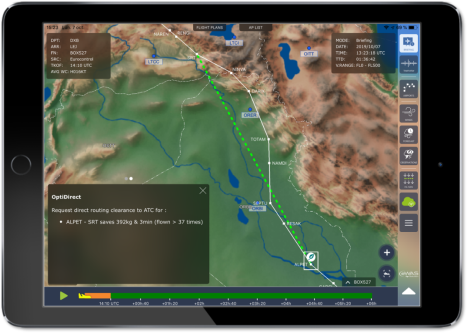GENEVA, 23 September 2020: SITA, a global IT provider for the air transport industry, is partnering with start-up Safety Line to help pilots and airlines limit carbon dioxide (CO2) emissions and operational costs by reducing fuel consumption of aircraft at key flight stages.
A flight can be roughly divided into three phases: climb, cruise and descent. Safety Line, a young French company that specializes in predictive big data solutions for airlines and airports, has made it its mission to help save aircraft fuel and reduce CO2 emissions during all these flight phases with a software suite called OptiFlight. The focus currently lies on the climb-out – the most fuel-consuming phase of a flight – and the cruise phase.

Improving the cruise
Safety Line’s software solutions for the cruise phase, OptiSpeed, OptiDirect and OptiLevel, collectively called OptiCruise, have been integrated in SITA’s widely used eWAS Pilot mobile application that provides accurate 4D weather forecasts and real-time updates from various sources to warn about weather hazards such as thunderstorms, lightning, clear air turbulence, strong winds, icing and even volcanic ash.
Safety Line’s OptiCruise allows pilots and airlines to achieve significant fuel savings and carbon emission reductions. OptiSpeed shows pilots the fuel and time impact of speed variations with the objective of on-time arrival at the best fuel/time ratio while OptiDirect recommends shortcuts based on historical flight data and indicates possible fuel and time savings. OptiLevel advises pilots on the best initial flight level and cruise level changes, taking tailwinds and headwinds into account.
Improving the climb
As part of the new partnership and through the ‘Digital Day of Operations’ portfolio, SITA now also offers Safety Line’s OptiClimb software. OptiClimb uses tail-specific machine learning performance models in combination with 4D weather forecasts, to recommend customized speed changes at different altitudes for each climb. The software predicts fuel-burn in tens of thousands of possible flight scenarios, and then issues recommended climb speeds to pilots ahead of each flight.
Safety Line data shows that climb fuel savings of 5 to 6% are possible for each flight without affecting passenger safety or comfort. On a yearly basis, this could reduce CO2 emissions by several thousands of tons and operational costs by several million dollars, depending on the size of the airline fleet. Safety Line estimates that 5.6 million tons of CO2 could be avoided if all airlines in the world were to use OptiClimb.
(Source: SITA)






